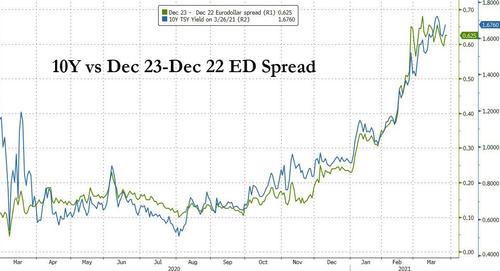(To be or not to be ? Bon, Shakespeare s'impose sur ce coup-là. note de rené)
Morgan Stanley Asks: Will The Market Move Towards The Fed, Or Will The Fed Shift Its Reaction Function Towards The Market
By Vishwanath Tirupattur, head of Credit Securitized Products Research and Strategy at Morgan Stanley.
A year ago this week, global equities bottomed as jobless claims spiked to all-time highs with the shutdown of the global economy as a result of the pandemic, and gloom started to set in. It was also around this time that massive monetary and fiscal policy intervention began, matching the enormity of the catastrophe. Today, hope is growing for light at the end of the tunnel, and the return of March Madness is a sign that we are on the path back towards normalcy.
Vis-à-vis our 2021 Outlook published in November 2020, the US economy is aligning with our economists' bull case, to which we assigned a likelihood of 20%. The bull case envisioned stronger growth than their above-consensus base case, with multiple COVID-19 vaccines increasing the speed and size of the roll-out, along with a more proactive US fiscal response than in their base case. This is exactly what we are seeing. The US$1.9 trillion American Rescue Plan was more than double our base-case expectation of 2021 fiscal stimulus, and another US$2+ trillion infrastructure package is in the works. The vaccine roll-out in the US has gathered pace, and the timeline for vaccinations has been brought forward, with 87.3 million people in the US receiving at least one dose of a COVID-19 vaccine and 47.4 million fully vaccinated as of last Thursday, according to the Centers for Disease Control and Prevention. Clearly, progress on the vaccination front has not been uniform globally, as parts of Europe and many emerging market economies lag the US. Still, growth is tracking the bull case narrative in our 2021 Outlook.
In the last six to eight weeks, risk assets have seemed listless. Since early February, the S&P 500 index is more or less unchanged and US investment grade credit spreads have stayed within a narrow range around mid-90bp. On the other hand, interest rates have risen steadily. Benchmark US 10-year Treasury yields have climbed about 60bp over the same period. Here is where fiscal and monetary policy meet face to face, and we need think about monetary policy in relation to fiscal policy. Let us dig into the underlying tensions in this policy confluence.
The conventional response to stronger-than-expected growth coupled with steep declines in headline unemployment would have steered monetary policy towards tightening in anticipation of higher inflation. In fact, the bond market is pricing in a 25bp rate hike at the start of 2023 and two more hikes of that size by the end of 2023. The thesis is that trillions of dollars in stimulus and an accelerating vaccination campaign mean front-end rates cannot stay this low without inflation spiraling out of control.
However, the FOMC’s ‘dot plot,' Chair Powell's comments during the post-FOMC meeting press conference last week and subsequent pronouncements by Fed officials have been stridently dovish and notably at odds with the bond market As Ellen Zentner, Matthew Hornbach and colleagues note, "Policy makers did not just 'double down' on dovish guidance, they 'tripled down'." They highlight that even though the median FOMC participant now believes core inflation will remain at or above 2% through 2023, that alone is not grounds for thinking about rate hikes because strong labor market conditions consistent with maximum employment take primacy in the Fed's reaction function. The Fed has not just raised the bar on the timing of future rate hikes. The Chair sounded equally dovish on tapering asset purchases when he stated, "We have said that we would continue asset purchases at this pace until we see substantial further progress, and that’s actual progress, not forecast progress. That’s a difference from our past approach."
The conventional policy response reflected in the bond market stands in stark contrast to the Fed’s unequivocal message. Will the market move towards the Fed, or will the Fed shift its reaction function towards the market's conventional thinking? Our global macro strategists Matthew Hornbach and Guneet Dhingra believe in the former, suggesting investors treat the recent technical-driven price action as noise and focus on the Fed’s signal. They recommend an overweight in the belly of the Treasury yield curve via 5s30s curve steepeners. Our economists continue to expect that conditions will be in place for the Fed to raise rates in 3Q23, with balance sheet tapering to start in January 2022.
Clearly, we are in uncharted waters in terms of policy. As my colleagues Andrew Pauker, Michael Wilson and team caution, this policy response may mean that the current economic cycle could run hotter but shorter than the prior three. They posit that risk-asset leadership is already shifting from 'early-cycle' to 'mid-cycle,' and that investors should position accordingly.

Aucun commentaire:
Enregistrer un commentaire